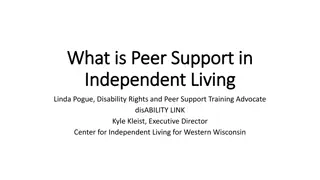
What is Peer-Led Learning? Strategies and Tips for Success
Peer-led learning is an innovative educational approach where students actively guide their peers through the learning process. This strategy fosters a collaborative environment, enhancing understanding, critical thinking, and engagement. Key compone
Download Presentation

Please find below an Image/Link to download the presentation.
The content on the website is provided AS IS for your information and personal use only. It may not be sold, licensed, or shared on other websites without obtaining consent from the author. If you encounter any issues during the download, it is possible that the publisher has removed the file from their server.
You are allowed to download the files provided on this website for personal or commercial use, subject to the condition that they are used lawfully. All files are the property of their respective owners.
The content on the website is provided AS IS for your information and personal use only. It may not be sold, licensed, or shared on other websites without obtaining consent from the author.
E N D
Presentation Transcript
What is Peer-Led Learning? Strategies and Tips for Success Peer-led learning is an innovative educational approach where students actively guide their peers through the learning process. This strategy fosters a collaborative environment, enhancing understanding, critical thinking, and engagement. Key components include selecting proficient peer leaders, providing structured training, and incorporating feedback mechanisms. The Concept of Peer-Led Learning
Peer-led learning shifts the educational dynamic, emphasizing mutual teaching and active participation. By explaining concepts in peer-friendly language, students often grasp material more effectively, leading to improved comprehension and retention. Benefits of Peer-Led LearningImproved Understanding: Students often find it easier to understand material explained by their peers.Enhanced Engagement: Active participation in peer-led activities boosts motivation and interest.Social Skills Development: Collaborative learning environments help students develop critical teamwork and communication skills.Confidence Building: Teaching others reinforces knowledge and boosts self-esteem.Implementing Peer-Led Learning ProgramsSet Clear Objectives: Define the goals of the peer-led program to align with the curriculum.Select Suitable Peer Leaders: Choose students with strong academic performance and leadership qualities.Provide Comprehensive Training: Equip peer leaders with facilitation techniques and subject matter expertise.Structure Sessions: Organize activities and discussions to maintain focus and engagement.Feedback Mechanism: Implement a system for collecting and acting on feedback from participants.Overcoming Challenges Implementing peer-led learning can face resistance and quality control issues. Address these by providing thorough training for peer leaders, continuously monitoring and evaluating sessions, and integrating technology to streamline processes. Case StudiesUniversity of California, Berkeley: Increased pass rates by 20% through peer-led learning in large courses.Massachusetts Institute of Technology (MIT): Noted higher student engagement and retention in engineering programs.Harvard University:
Enhanced comprehension and analytical skills in humanities through peer-led seminars.Future Trends Emerging trends in peer-led learning include integrating AI and virtual reality for immersive experiences, global collaboration for diverse perspectives, and data analytics to personalize learning. Conclusion Peer-led learning offers transformative benefits, enhancing comprehension, critical thinking, and social skills. By effectively implementing and supporting peer-led programs, educational institutions can empower students and foster a collaborative learning environment. For more detailed strategies and tips on implementing peer-led learning, visit the full article here.






















